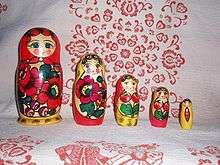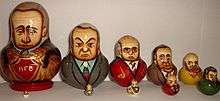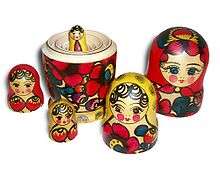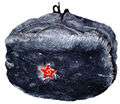Matryoshka doll

A matryoshka doll (Russian: матрёшка; IPA: [mɐˈtrʲɵʂkə], matrëška), also known as a Russian nesting doll, or Russian doll,[1] is a set of wooden dolls of decreasing size placed one inside another. The name "matryoshka" (матрёшка), literally "little matron", is a diminutive form of Russian female first name "Matryona" (Матрёна) or "Matriosha".[2]
A set of matryoshkas consist of a wooden figure which separates, top from bottom, to reveal a smaller figure of the same sort inside, which has, in turn, another figure inside of it, and so on.
The first Russian nested doll set was made in 1890 by Vasily Zvyozdochkin from a design by Sergey Malyutin, who was a folk crafts painter at Abramtsevo. Traditionally the outer layer is a woman, dressed in a sarafan, a long and shapeless traditional Russian peasant jumper dress. The figures inside may be of either gender; the smallest, innermost doll is typically a baby turned from a single piece of wood. Much of the artistry is in the painting of each doll, which can be very elaborate. The dolls often follow a theme; the themes may vary, from fairy tale characters to Soviet leaders. Matryoshka dolls are often referred to as "babushka dolls", babushka meaning "grandmother" or "elderly woman".
History

The first Russian nested doll set was carved in 1890 by Vasily Zvyozdochkin, designed by Sergey Malyutin who was a folk crafts painter in the Abramtsevo estate of Savva Mamontov". A Russian industrialist and patron of arts.[3][4] The doll set was painted by Malyutin. Malyutin's doll set consisted of eight dolls—the outermost was a girl in a traditional dress holding a rooster. The inner dolls were girls and a boy, and the innermost a baby.[3]
Zvyozdochkin and Malyutin were inspired by a doll from Honshu, the main island of Japan. Sources differ in descriptions of the doll, describing it as either a round, hollow daruma doll, portraying a bald old Buddhist monk,[5] or a Seven Lucky Gods nesting doll.[3][4][6]
Savva Mamontov's wife presented the dolls at the Exposition Universelle (1900) in Paris, where the toy earned a bronze medal. Soon after, matryoshka dolls were being made in several places in Russia and shipped around the world.
Themes in dolls
Matryoshka dolls are often designed to follow a particular theme; for instance, peasant girls in traditional dress. Originally, themes were often drawn from tradition or fairy tale characters, in keeping with the craft tradition—but since the 20th century, they have embraced a larger range, including Soviet leaders.
Modern artists create many new styles of nesting dolls. Common themes include floral, Christmas, Easter, religious, animal collections, portraits and caricatures of famous politicians, musicians, athletes, astronauts, "robots," and popular movie stars. Matryoshka dolls that featured communist leaders of Russia became very popular among Russian people in the early 1990s, after the collapse of the Soviet Union. Today, some Russian artists specialize in painting themed matryoshka dolls that feature specific categories of subjects, people or nature. Areas with notable matryoshka styles include Sergiyev Posad, Semionovo (now the town of Semyonov),[7] Polkhovsky Maidan, and Kirov.

During Perestroika, the leaders of the Soviet Union became a common theme of matryoshkas. The largest, outside figure was that of Mikhail Gorbachev, followed by Leonid Brezhnev (Yuri Andropov and Konstantin Chernenko almost never appear due to the short length of their respective terms), Nikita Khrushchev, Joseph Stalin and finally the smallest, Vladimir Lenin. Newer versions start with Vladimir Putin and then follow with Dmitry Medvedev, Boris Yeltsin, Mikhail Gorbachev, Joseph Stalin and Vladimir Lenin. Some include Putin, Medvedev, Yeltsin, Gorbachev, Brezhnev, Khrushchev, Stalin, Lenin, and finally Czar Nicholas II, a total of nine dolls.
World record
The largest set of matryoshka dolls in the world is a 51-piece set hand-painted by Youlia Bereznitskaia of Russia, completed in 2003. The tallest doll in the set measures 53.97 centimetres (21.25 in); the smallest, 0.31 centimetres (0.12 in). Arranged side-by-side, the dolls span 3.41 metres (11 ft 2.25 in).[8]
As metaphor
Matryoshkas are used metaphorically, as a design paradigm, known as the "matryoshka principle" or "nested doll principle". It denotes a recognizable relationship of "object-within-similar-object" that appears in the design of many other natural and crafted objects. Examples of this use include the matrioshka brain and the Matroska media-container format.
The onion metaphor is of similar character. If the outer layer is peeled off an onion, a similar onion exists within. This structure is employed by designers in applications such as the layering of clothes or the design of tables, where a smaller table nests within a larger table, and a smaller one within that.
The Matroska (MKV) multimedia container format derives its name from Matryoshka, alluding to the container being able to hold many different types of content streams.
See also
References
- ↑ russian doll. (n.d.). Collins English Dictionary - Complete & Unabridged 10th Edition. Retrieved April 14, 2016.
- ↑ Oxford English Dictionary Online. Accessed 2011-03-25.
- 1 2 3 "Matryoshka - Soul of Russia". Russian Life. Retrieved 2011-10-23.
- 1 2 Billington, James H. (2004). Russia in search of itself. Woodrow Wilson Center Press. p. 148,208. ISBN 978-0-8018-7976-0. Retrieved 2016-04-30.
- ↑ "Три матрешки" (Three Matryoshkas), Vokrug sveta, July 1980.
- ↑ "Eastern roots of the most famous Russian toy". Russian Geographical Society. 2011-03-24. Archived from the original on March 1, 2014.
- ↑ "The hardworking women behind the matryoshkas hope for an Olympic boost". July 18, 2011, Natalya Radulova, Ogonyok
- ↑ http://www.guinnessworldrecords.com/world-records/largest-russian-nesting-doll-%28matryoshka%29/
External links
-
 Media related to Matryoshka dolls at Wikimedia Commons
Media related to Matryoshka dolls at Wikimedia Commons



